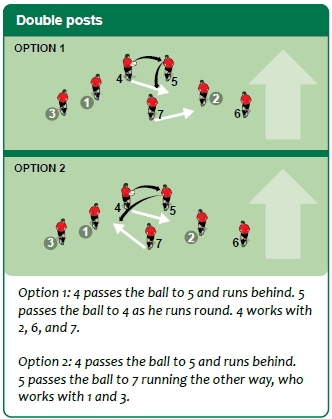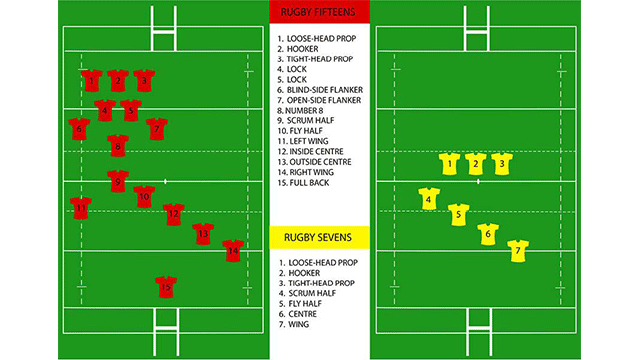Rugby 7s is a fast-paced, exciting version of rugby. It’s played with seven players on each team.
Rugby 7s has gained popularity due to its speed and simplicity. This version of rugby is easier to understand and fun to watch. Unlike traditional rugby, it has shorter matches, making it ideal for new players and fans. If you want to learn the basics of Rugby 7s, you’re in the right place.
This guide will help you understand the rules, positions, and strategies. By the end, you’ll be ready to enjoy and even play Rugby 7s with confidence. Let’s get started!
Introduction To Rugby 7s
Rugby 7s is an exciting and fast-paced sport. It is a variation of traditional rugby. It features only seven players on each team. Matches are short, often lasting just 14 minutes. This makes the game intense and action-packed.
What Is Rugby 7s?
Rugby 7s is a form of rugby union. Unlike the traditional rugby union, it has fewer players. Each team consists of seven players instead of fifteen. The game is played on a full-sized rugby field. The matches are divided into two halves, each lasting seven minutes. This results in a total of 14 minutes of playtime.
The main objective is to score more points than the opposing team. Points are scored through tries, conversions, and penalty goals. The game demands speed, agility, and teamwork. Players must be quick and strategic. This keeps the audience on the edge of their seats.
History And Evolution
The history of Rugby 7s dates back to 1883. The sport originated in Melrose, Scotland. It was created by Ned Haig, a butcher and rugby player. Haig wanted to raise funds for his local rugby club. He proposed a shorter version of rugby union. This idea led to the first-ever Rugby 7s tournament.
Over the years, Rugby 7s gained popularity. It spread across the globe. The sport became particularly popular in countries like New Zealand, Fiji, and South Africa. In 1993, the Rugby 7s World Cup was introduced. This event further increased the sport’s global appeal.
In 2016, Rugby 7s made its debut in the Olympic Games. The inclusion in the Olympics marked a significant milestone. It showcased the sport to a wider audience. Today, Rugby 7s continues to grow. It is celebrated for its dynamic and thrilling nature.
| Aspect | Traditional Rugby | Rugby 7s |
|---|---|---|
| Number of Players | 15 | 7 |
| Match Duration | 80 minutes | 14 minutes |
| Field Size | Full-sized | Full-sized |
Rugby 7s is a thrilling sport. It combines the essence of traditional rugby with a fast-paced format. This makes it accessible and enjoyable for players and spectators alike.
Basic Rules
Rugby 7s is an exciting, fast-paced sport. It has basic rules that are simple to understand. These rules help keep the game fair and fun for all players.
Game Duration
A Rugby 7s match consists of two halves. Each half is only seven minutes long. There is a short break at halftime, lasting just two minutes. This makes the total game duration only 16 minutes.
If the match is a final and ends in a tie, extra time is played. Each period of extra time is five minutes long.
Scoring System
In Rugby 7s, scoring is similar to traditional rugby. There are several ways to score points:
- Try: A try is worth five points. A player scores a try by grounding the ball in the opponent’s in-goal area.
- Conversion: After scoring a try, the team gets a chance for a conversion. This kick is worth two points. The player kicks the ball from a spot in line with where the try was scored.
- Penalty Kick: A penalty kick is worth three points. A team can attempt a penalty kick when the opposing team commits a foul.
- Drop Goal: A drop goal is worth three points. A player scores a drop goal by kicking the ball through the goalposts during open play.
Understanding these basic rules makes it easier to enjoy and play Rugby 7s. The simplicity and speed of the game make it thrilling to watch and play.
Essential Equipment
Playing Rugby 7s requires the right gear to ensure safety and performance. This section covers all the essential equipment needed for a game of Rugby 7s. From required gear to safety equipment, we’ve got you covered.
Required Gear
To play Rugby 7s, you need some basic gear. Each piece plays a crucial role in the game.
- Rugby Ball: The ball used in Rugby 7s is oval-shaped. It is made of leather or synthetic material.
- Rugby Boots: Boots have studs that provide grip on the field. They are essential for quick movements.
- Rugby Kit: This includes a jersey, shorts, and socks. The kit is designed to be durable and comfortable.
Safety Equipment
Safety is paramount in Rugby 7s. The following gear helps protect players from injuries.
- Mouthguard: This protects your teeth and gums. It is a must-have for every player.
- Headgear: Soft-padded headgear reduces the risk of head injuries. It is lightweight and comfortable.
- Shoulder Pads: These pads protect your shoulders and upper body. They are worn under the jersey.
Having the right equipment is key to playing Rugby 7s safely and effectively. Make sure you have all the essential gear before hitting the field.

Credit: lakefront7s.com
Player Positions
Understanding player positions is key to learning how to play Rugby 7s. Each player has a specific role on the field. This section will explore the different player positions, starting with forwards and then moving to backs.
Forwards
In Rugby 7s, the forwards are the players who engage in physical confrontations. They usually have the task of winning the ball in scrums and lineouts. There are three types of forwards:
- Hooker: The hooker is central in the scrum. They strike the ball for their team.
- Prop: Props are on either side of the hooker. They provide stability in the scrum.
- Lock: The lock usually jumps in the lineouts. They are also key in rucks and mauls.
Backs
The backs are the players who create scoring opportunities. They often run with the ball and use speed to outmaneuver opponents. There are four types of backs:
- Scrum-half: The scrum-half links the forwards and backs. They distribute the ball quickly.
- Fly-half: The fly-half directs the attack. They make crucial decisions on the field.
- Center: Centers are versatile. They can both attack and defend effectively.
- Wing: Wingers are usually the fastest players. They finish off attacks and score tries.
Each position has unique responsibilities. Knowing these roles helps players understand their tasks on the field.
Basic Skills
Learning the basic skills of Rugby 7s is crucial. These skills will help you become a better player. This section covers two important skills: passing techniques and tackling fundamentals. Let’s dive in!
Passing Techniques
Passing is an essential skill in Rugby 7s. It helps your team move the ball quickly. Here are some key points to remember:
- Grip the Ball: Hold the ball with both hands. Your fingers should be spread out.
- Body Position: Stand with your feet shoulder-width apart. Keep your knees slightly bent.
- Pass Direction: Always pass the ball sideways or backwards. Forward passes are not allowed.
- Follow Through: After releasing the ball, follow through with your hands. This helps with accuracy.
Practice passing with a partner. Start with short passes. Gradually increase the distance.
Tackling Fundamentals
Tackling is another important skill in Rugby 7s. It helps stop the opposing team’s progress. Here are some basics:
- Get Low: Bend your knees and lower your body. This gives you a strong base.
- Head Position: Keep your head to the side of the opponent. Never place your head in front.
- Wrap Your Arms: Use both arms to wrap around the opponent’s legs or waist. This ensures a secure tackle.
- Drive with Your Legs: Push off with your legs to bring the opponent to the ground. Maintain control until the tackle is complete.
Practice tackling with a teammate. Focus on technique and safety. Proper technique prevents injuries and ensures a successful tackle.

Credit: www.youtube.com
Game Strategies
Understanding the game strategies in Rugby 7s is crucial for success. The game is fast-paced and requires quick thinking. Both offensive and defensive tactics play a key role. Let’s delve into these strategies.
Offensive Tactics
In Rugby 7s, offensive tactics are all about speed and space. Here are some key tactics to consider:
- Quick Passes: Keep the ball moving to avoid tackles.
- Support Play: Always have a teammate nearby to receive the ball.
- Switching Direction: Change the direction of play to confuse the defense.
- Looping Runs: Use looping runs to create overlaps.
Using these tactics helps you break through the defense. Speed and agility are crucial.
Defensive Techniques
Defensive techniques in Rugby 7s focus on organization and teamwork. Here are some key techniques:
- Line Defense: Stay in a line to cover the width of the field.
- Pressing: Move up quickly to pressure the opposing team.
- Covering: Always cover your teammates to prevent gaps.
- Tackling: Make strong, effective tackles to stop the attack.
These techniques require good communication. Always stay alert and ready.
| Offensive Tactics | Defensive Techniques |
|---|---|
| Quick Passes | Line Defense |
| Support Play | Pressing |
| Switching Direction | Covering |
| Looping Runs | Tackling |
Mastering these game strategies can make a big difference. Focus on both offense and defense. Improve your skills in these areas and see the results on the field.
Training Tips
Training for Rugby 7s requires dedication and a well-rounded approach. This involves focusing on fitness, skill development, and teamwork. Here are some essential training tips to get you started.
Fitness Drills
Fitness is crucial in Rugby 7s due to the fast-paced nature of the game. Here are some effective drills:
- Sprint Intervals: Short bursts of speed improve your agility.
- Endurance Runs: Long-distance runs build stamina.
- Agility Ladders: Improve footwork and quick direction changes.
- Plyometrics: Jumping exercises enhance explosive power.
| Drill | Purpose |
|---|---|
| Sprint Intervals | Improve speed and agility |
| Endurance Runs | Build stamina |
| Agility Ladders | Enhance footwork |
| Plyometrics | Increase explosive power |
Skill Development
Rugby 7s is not just about speed and endurance. Skills play a huge role too:
- Passing Drills: Practice different types of passes. Focus on accuracy.
- Tackling Practice: Learn to tackle safely and effectively.
- Ball Handling: Improve your grip and control of the ball.
- Kicking Drills: Enhance your ability to kick with precision.
| Skill | Description |
|---|---|
| Passing Drills | Focus on accurate passing |
| Tackling Practice | Learn safe and effective tackles |
| Ball Handling | Improve grip and control |
| Kicking Drills | Enhance kicking precision |
By focusing on these fitness drills and skill development exercises, you will be better prepared for Rugby 7s. Remember, consistency is key.

Credit: www.rugbycoachweekly.net
Common Mistakes
Playing Rugby 7s can be both exciting and challenging. Many players make common mistakes that hinder their performance. Understanding these mistakes can help improve your game.
Avoiding Penalties
Penalties in Rugby 7s can easily change the game’s direction. Avoiding them is crucial for your team’s success.
- Offside: Stay behind the hindmost foot of the ruck or scrum. Moving ahead can lead to penalties.
- High tackles: Always tackle below the shoulders. High tackles are not allowed and will be penalized.
- Not releasing the ball: Once tackled, release the ball immediately. Holding on too long results in a penalty.
Improving Teamwork
Rugby 7s relies heavily on teamwork. Poor teamwork can lead to mistakes and lost games.
- Communication: Always talk to your teammates. Clear communication ensures everyone knows their role.
- Support play: Always stay close to the ball carrier. Provide options for passes and support in tackles.
- Trust: Trust your teammates. Knowing they will do their part helps you focus on your own role.
By focusing on these areas, you can avoid common mistakes in Rugby 7s. This will help you play better and enjoy the game more.
Joining A Team
Joining a team is one of the first steps to playing Rugby 7s. It offers camaraderie, training, and a chance to compete. But where do you start? Here’s a guide to help you join a Rugby 7s team.
Finding Local Clubs
Start by searching for local rugby clubs online. Use keywords like “Rugby 7s club near me”. Many clubs have websites or social media pages. These platforms provide information about training schedules and membership. Visit your local sports centers. They often have bulletin boards with club information. Asking friends or colleagues can also be helpful. Someone might already be part of a team.
First Practice Session
Once you find a club, attend your first practice session. Wear appropriate sports gear. Bring water and a positive attitude. Arrive early to introduce yourself to the coach and players. Warm-up exercises are usually the first activity. Follow the coach’s instructions carefully. During drills, focus on basic skills like passing and running. Don’t worry if you make mistakes. Everyone was a beginner once. Pay attention to teamwork. Rugby 7s is all about working together. Enjoy the process and have fun.
Conclusion And Next Steps
You’ve learned the basics of Rugby 7s. Now, what next? This section will guide you through setting goals and continuing your education in the sport.
Setting Goals
Setting goals is crucial for your progress in Rugby 7s. Here are steps to help you:
- Identify Your Weaknesses: Know where you need to improve.
- Set Short-Term Goals: Focus on small, achievable targets.
- Create a Training Plan: Make a schedule that fits your life.
- Track Progress: Keep a record of your improvements.
Regularly review and update your goals. This keeps you motivated and focused.
Continuing Education
Rugby 7s is a complex sport. Continuing education helps you stay ahead.
- Watch Professional Games: Learn from the best players.
- Read Books and Articles: Gain deeper insights.
- Attend Workshops: Participate in coaching clinics.
- Join Online Communities: Engage with other players and coaches.
Always seek new knowledge. This broadens your understanding and skill set.
Frequently Asked Questions
What Are The Basic Rules Of Rugby 7s?
Rugby 7s is played with seven players per team. Matches consist of two seven-minute halves. Scoring follows traditional rugby rules. Players aim to score tries and conversions.
How Long Is A Rugby 7s Game?
A Rugby 7s game lasts 14 minutes in total. Each half is seven minutes long. There is a short halftime break.
What Equipment Is Needed For Rugby 7s?
Players need a rugby ball, cleats, mouthguards, and appropriate sportswear. Protective gear like scrum caps is optional but recommended.
How Does Scoring Work In Rugby 7s?
Scoring in Rugby 7s involves tries, conversions, and penalty goals. A try is worth five points. Conversions are worth two points.
Conclusion
Playing Rugby 7s can be a fun and rewarding experience. Follow the basic rules and practice often. Stay fit and work on your teamwork. Enjoy the fast pace and the thrill of the game. Remember, every player counts in Rugby 7s.
Keep learning and improving your skills. Have fun and make new friends on the field. Rugby 7s offers excitement and a great workout. Give it a try and experience the joy of this sport.


